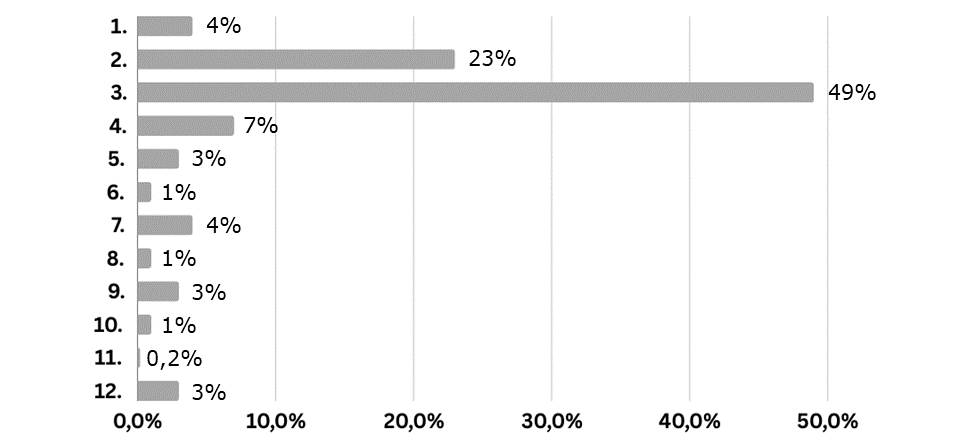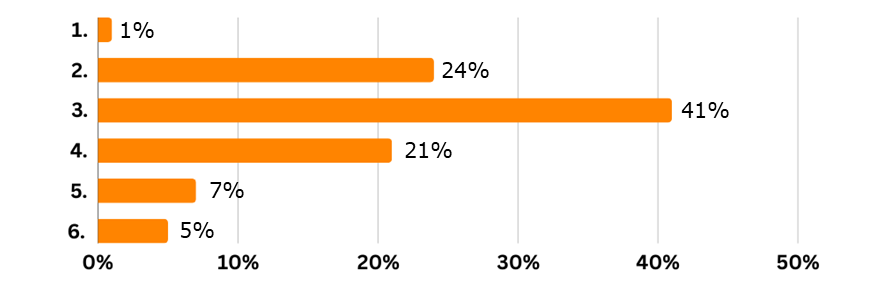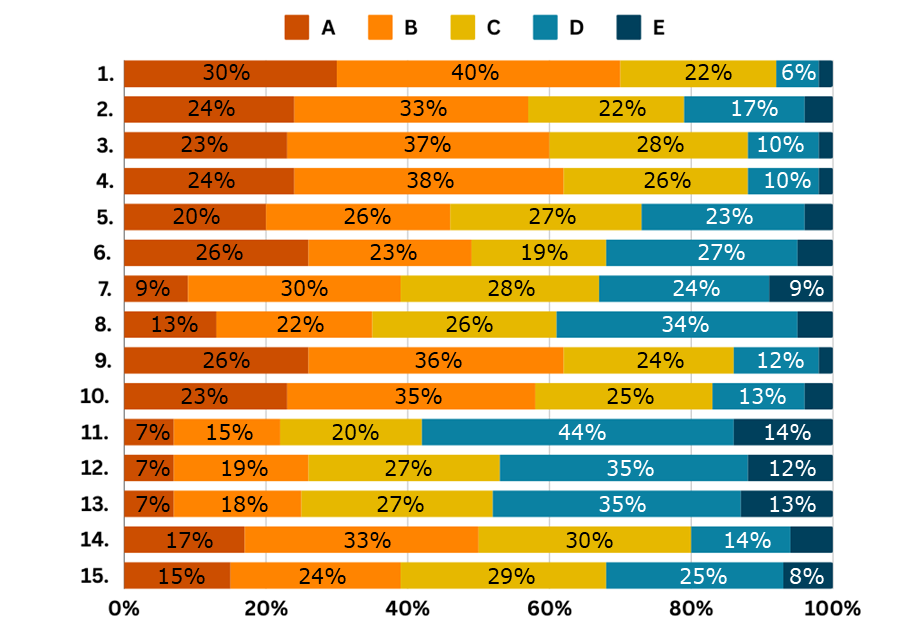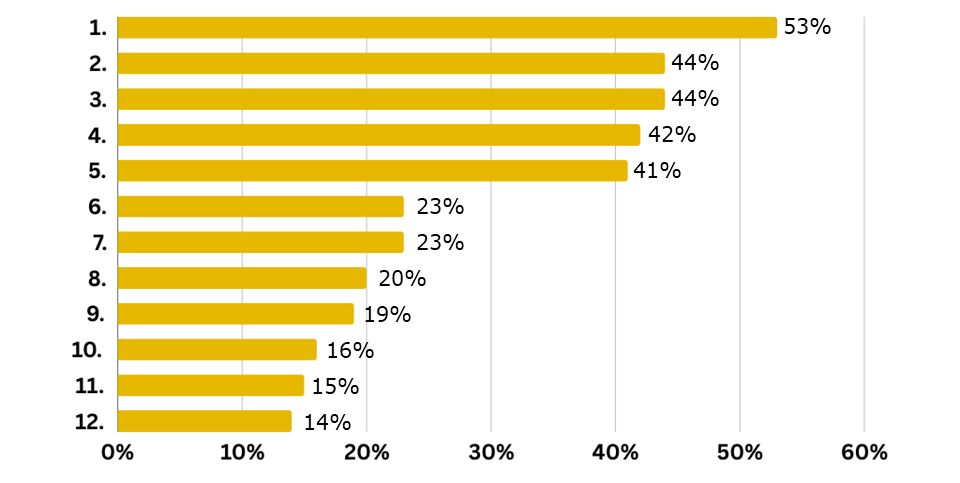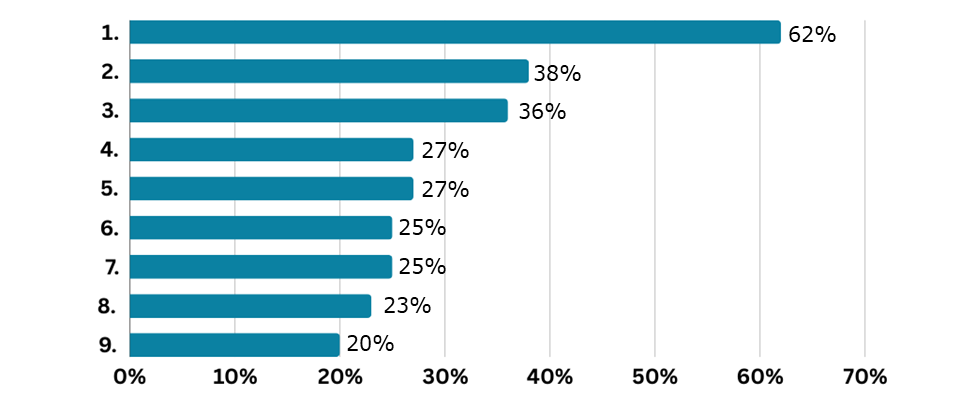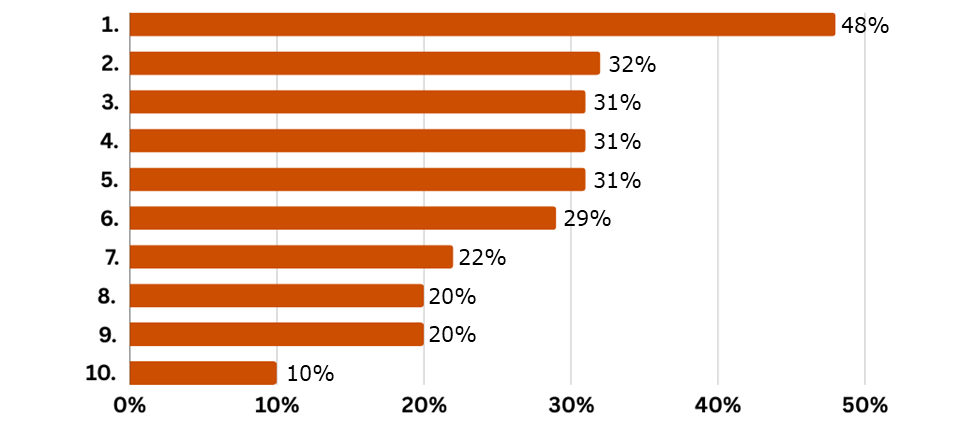Survey on language learning - Results

Learning a language is a fundamental and enriching aspect of personal development, serving multiple purposes.
According to the Council Recommendation on key competences for lifelong learning, multilingualism is one of the eight key competences required for social inclusion, employability, a healthy and sustainable lifestyle, and personal fulfilment. In a recent Eurobarometer survey, 56% of EU citizens and 79% of young Europeans aged 15-24 said they are able to hold a conversation in a different language.
However, language learning often only focuses on a few EU languages, notably English. Among the numerous factors affecting language learning, there is the question of how languages are taught in schools. The Council Recommendation on a comprehensive approach to the teaching and learning of languages aims to enhance language competences among young Europeans It aims at young people acquiring, before the end of upper secondary, proficiency in the language of schooling and knowledge of two additional languages, while valuing linguistic diversity in general.
The survey gathered 1109 responses from platform visitors, most of whom were primary and secondary school teachers from Italy, Spain, Türkiye and Greece.
Which of the following best describes your role?
- Teacher – early years education
- Teacher – primary education
- Teacher – secondary education
- Teacher – vocational education
- School head
- National, regional or local authority
- Teacher educator/trainer
- Education policymaker
- Parent
- In-school support (e.g. school librarian, career counsellor)
- External practitioner (visiting schools)
- Other educational professional/stakeholder
1 - How many languages are offered in your school or a school you know of?
Almost all respondents work in or know of schools where foreign languages are taught. Only 1% of respondents reported that no foreign languages are offered at their school. Approximately 24% indicated that their school offers one foreign language, while 41% reported the availability of two foreign languages, the most frequently offered option. Additionally, 21% noted access to three foreign languages, and a smaller percentage (7%) mentioned four languages being available. Five or more foreign languages were mentioned by 5% of respondents.
- None (only the native language)
- One foreign language
- Two foreign languages
- Three foreign languages
- Four foreign languages
- Five or more foreign languages
2 - How interested are pupils in learning foreign languages?
The typical pupil is moderately interested in learning a foreign language: a small majority (51%) of respondents considered that pupils have a moderate level of interest in language learning. 30% of respondents felt that pupils have a high or very high interest in learning foreign languages, and 18% reporting low or very low interest.
- Very low interest
- Low interest
- Moderate interest
- High interest
- Very high interest
- I don’t know
3 - To what extent are the following strategies typically used in language teaching in your school?
The responses show that integrating communicative language teaching methods is highly prevalent in language teaching, with 70% of respondents indicating its use to a great extent or somewhat. Similarly, 62% reported that schools use authentic materials (e.g. newspapers, magazines, TV recordings and podcasts), and encourage pupils’ self-directed learning as a common strategy. Tailoring instruction to meet individual student needs is also common (60%), while 58% mentioned the use of language learning apps or online platforms.
Content and language integrated learning (CLIL) methods were reported by 57% of the respondents, while 50% mentioned the use of formative assessment techniques. Participation in Erasmus+ projects and exchange visits (49%) and incorporating project-based learning activities through eTwinning (46%) were also reported.
Less prevalent strategies include the use of e-portfolios (39%), flipped classroom models (39%) and extracurricular activities - language clubs and community partnerships (35%), for example. The least common strategies are the use of AI as a language learning tool (26%), accessing resources from the European School Education Platform (25%) and using the European Online Language Support (22%).
A. To a great extent / B. Somewhat / C. A little / D. Not at all / E. I don’t know
- Integrating communicative language teaching methods (e.g. role-playing, real-life scenarios).
- Content and language integrated learning (learning academic content in a second language).
- Tailoring instruction according to students’ individual needs (differentiated teaching).
- Encouraging students’ self-directed learning.
- Incorporating project-based learning activities through eTwinning.
- Participating in Erasmus+ programmes, exchange visits or student mobility opportunities.
- Adopting flipped classroom models (i.e. reversing traditional lectures and homework).
- Extracurricular activities such as language clubs and community partnerships.
- Using authentic materials, such as newspapers, magazines, TV recordings and podcasts.
- Language learning apps or online platforms.
- Using the European Online Language Support via EU Academy (for Erasmus+ projects).
- Language learning tools using artificial intelligence (AI).
- Accessing resources from the European School Education Platform.
- Integrating formative assessment techniques (e.g. peer feedback and self-assessment.
- Using e-portfolios, i.e. digital collections of documents, images, videos, etc., to track student progress.
4 - Which of the following factors are the most challenging when learning a language?
The most prominent challenge in language learning is the limited exposure to the target language outside the classroom (53%). Following this, large class sizes and a lack of opportunities for authentic language practice (44%), motivation or interest among learners (42%) and limited instructional time for language learning (41%) were seen as hindrances.
Other challenges include inadequate support for diverse learning needs and ineffective teaching methodologies, each noted by 23% of respondents. Other reasons such as finding language learning more difficult compared to other subjects, regarding languages as less useful for life and career prospects, cultural or linguistic barriers and insufficient professional development for language teachers were each considered as challenges by 20% or less of respondents.
- Limited exposure to the target language outside the classroom.
- Large class sizes hindering language instruction.
- Lack of opportunities for authentic language practice.
- Lack of motivation or interest among students.
- Limited time allocated for language instruction.
- Inadequate support for students with diverse learning needs.
- Ineffective teaching methodologies or approaches.
- Perceived difficulty of learning a language compared to other subjects in the curriculum.
- Languages not seen as useful in life and careers.
- Insufficient professional development opportunities for language teachers.
- Cultural or linguistic barriers that affect language acquisition.
- Insufficient resources and materials for language learning.
5 - Which of the following do you consider to be the most effective strategies to enhance language teaching and learning?
The most favoured approach (62%) for enhancing language teaching and learning involves exchange programmes or partnerships with native speakers and opportunities to study abroad. Implementing active learning methods that prioritise outcomes over memorisation (38%), and promoting extracurricular activities and events to supplement classroom learning (36%) are also seen as effective strategies.
The integration of technology-enhanced language learning tools and resources, along with the adoption of flexible and personalised learning pathways to cater to individual needs, both garnered support from 27% of respondents. Professional development and training for language teachers, as well as the application of content and language integrated learning (CLIL), each received 25% support. Allocating sufficient resources for language education within the school curriculum was backed by 23% of respondents, while emphasising cultural integration and understanding alongside language acquisition was favoured by 20%.
- Exchange programmes or partnerships with native speakers or opportunities to study abroad.
- Implementing active learning methods that prioritise outcomes over memorisation.
- Promotion of extracurricular activities and events to supplement classroom learning.
- Integration of technology-enhanced language learning tools and resources.
- Adoption of flexible and personalised learning pathways to cater to individual needs.
- Provision of professional development and training for language teachers.
- Application of content and language integrated learning (CLIL).
- Allocation of sufficient resources for language education within the school curriculum.
- Emphasis on cultural integration and understanding alongside language acquisition.
6 - Which of these scenarios do you expect to see in the future regarding language learning?
Exchange programmes and cross-border school partnerships are anticipated to become more prevalent, with nearly half of respondents (48%) predicting this trend. Language teaching methods are expected to increasingly emphasise authentic cultural experiences, such as cooking, music and films (32%). 31% predict that more children will begin learning a foreign language at an early age, while an equal percentage expect artificial intelligence (AI) to simplify language learning through personalised pathways and real-time feedback. Additionally, 31% foresee a greater integration of language learning platforms and apps into classroom settings.
Some respondents believe that blended learning models (29%) and tools for virtual and augmented reality (22%) will become more widespread. A smaller proportion thinks that the curriculum will include more cultural components to foster multilingual competences (20%), that CLIL (content and language integrated learning) approaches will become more popular (20%) or that AI will increase learning of less commonly spoken languages (10%).
- Exchange programmes and cross-border school partnerships will become more common.
- Language teaching methods will prioritise authentic cultural experiences (e.g. cooking, music, films).
- More language learning platforms and apps will be integrated into classroom teaching.
- AI will make language learning easier (e.g. by personalising learning pathways, providing real-time feedback and real-time voice translation).
- More children will start learning a foreign language at an early age.
- Blended learning models (classroom instruction with online resources) will become widespread.
- Virtual reality and augmented reality will be used to create immersive language learning.
- The curriculum will include more cultural components to foster multilingual competences.
- CLIL approaches will be adopted to a greater extent.
- AI will enable increased learning of less commonly spoken languages.
Discussion
The survey results show that a significant proportion of schools offer foreign languages, even at pre- and primary school level (with 4% and 23% respondents respectively). According to the respondents, almost one in three pupils (30%) have a high or very high interest in language learning, although most pupils (51%) are only moderately interested in learning a foreign language. The widespread adoption of communicative language teaching methods and the use of authentic materials are pivotal in maintaining the engagement of pupils and improving their language proficiency. Tailoring instruction to individual needs and making use of technology, such as language learning apps, are also common practices that enhance the learning experience.
Despite these efforts, challenges remain, particularly in providing sufficient exposure to the target language outside the classroom and addressing issues related to class size, pupil motivation and teaching time. There is a clear preference among respondents for exchange programmes and partnerships with native speakers as strategies to bolster language learning, alongside the integration of active learning methods and extracurricular activities. Looking forward, there is optimism about the future of language learning and teaching, with an anticipated increase in exchange programmes, early language learning and the use of AI and technology to facilitate personalised and immersive learning experiences.
Further reading
Additional information
-
Education type:School Education
-
Target audience:TeacherStudent TeacherHead Teacher / PrincipalTeacher EducatorGovernment staff / policy makerParent / Guardian
-
Target audience ISCED:Primary education (ISCED 1)Lower secondary education (ISCED 2)Upper secondary education (ISCED 3)

